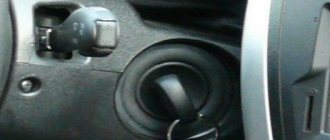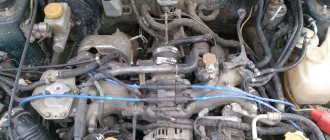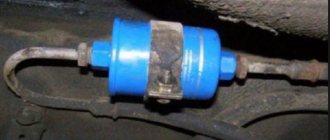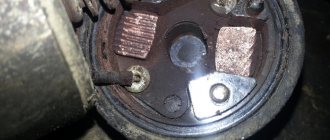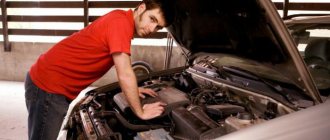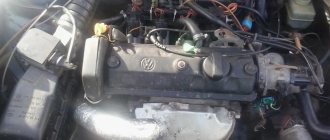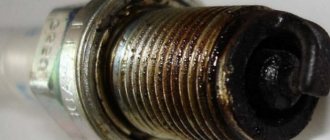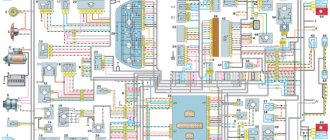If somewhere along the way your VAZ 2112 stalls, starts up briefly, and then turns off again, then it is unlikely that you will be able to fix the problem in the field. Although there are no rules without exceptions, it happens that the tank simply runs out of fuel, and the sensor is lying. But oddly enough, it is much easier to detect a breakdown in a car when it shows no signs of life. Whether it will be possible to revive him on the road is a difficult question, but it’s worth a try. There are several recommendations.
Malfunctions in the air mixture supply system
Here the problem lies either in a clogged air filter or in the failure of the regulator responsible for idling the car. In this case, your car will stall all the time when you gain speed or when you release the gas when you release the accelerator.
To solve the problem, remove and inspect the air filter. If there is serious contamination or chips, replace it. To diagnose and replace the idle speed regulator, you will need the help of qualified car service employees.
Electrical faults
There are several reasons why the engine may stall:
- ignition switch malfunction;
- the fuse in the fuel pump circuit has burned out;
- no voltage is supplied to the spark plugs;
- one of the sensors on which the operation of the power unit depends has failed.
First of all, it is recommended to check the operation of the fuel pump; when the ignition is turned on, it emits a quiet hum (coming from the rear of the car). When there is no such sound, it is necessary to open the VAZ 2112 fuse box and check the condition of fusible link No. 3, which closes the fuel supply relay circuit. The blown fuse must be replaced with a new or temporary “bug” made of copper wire and try to start the engine. If the car starts, feel free to continue on your way.
Without knowledge of the electrical part of the car, a breakdown of the ignition switch cannot be avoided, and it is not easy to diagnose it. Therefore, it is recommended to check for a spark on the spark plugs, for which you need to unscrew one of them and securely attach it to a metal part of the engine by connecting a high-voltage wire. Then turn on the starter and watch for sparking. If there is a spark, good, we need to look in a different direction. If it is not present, the following breakdowns may occur:
- the simplest thing is failure of high-voltage wires or spark plugs;
- malfunction of the ignition switch or the corresponding relay;
- the switch or ignition distributor slider has become unusable (on carburetor cars);
- The crankshaft position sensor has failed (on cars with an injector).
If high-voltage wires or spark plugs can be replaced, then the breakdown of other elements must first be accurately diagnosed, which is hardly possible in the middle of a field. In addition, the throttle position or air flow sensor may break, causing the controller to switch the injector to emergency mode. Then the car may often stall at idle.
Car exhaust system problem
The engine may also stall if the tubes responsible for removing gases are malfunctioning. At full speed, the car will quickly begin to “choke”, and pressing the gas pedal completely stops the engine. Malfunctions in the operation of the exhaust pipe system in 90% of cases are caused by contamination and clogging of the muffler. However, the catalyst may also fail.
In the first case, carefully clean the muffler and remove foreign objects from there. If there are problems with the catalyst, conduct a complete diagnosis of the exhaust system and replace this element.
car muffler This problem is associated with malfunctions in the design of the vacuum booster. The symptoms are as follows: as soon as you try to brake sharply at full speed, you will see how quickly the engine stalls. This defect can be eliminated by repairing the amplifier adjuster or replacing the entire mechanism completely.
The cause of a stalled engine is the spark plugs
In 50% of cases, the problem is due to the fact that the spark plugs simply do not produce a spark. This failure occurs as a result of 3 reasons:
- contacts become clogged;
- plaque forms along the entire contour of the candle;
- malfunction when supplying voltage to the spark plug.
However, the most popular is still black carbon deposits on the spark plugs, which prevents the spark from appearing or causes it to work periodically.
Tip: if the spark plug set malfunctions, you will hear a “triple” sound that is uncharacteristic of the engine. In this case, the car will jerk strongly while moving. As a result, the engine will either stall on its own, or you will need to turn it off and turn the ignition on again.
If you see dirt on the surface of the contacts, this indicates the need to replace a low-quality type of fuel or check the serviceability of the oil supply systems. It is the oil supply adjustment sensors that can splash the spark plugs with it if there is a problem. Also, oil that appears on a set of spark plugs may indicate serious damage to components in the engine cylinders. Be sure to check the engine at a car service center. Otherwise, further operation may lead to expensive replacement of jet rods and even the entire set of pistons.
If you systematically use low-quality gasoline samples, you may find a red-brown coating on the contour of the spark plug. In this case, cleaning will not help - it is better to immediately replace the entire set after a new refill. If you find that the car periodically turns off at full speed, but starts easily even with clean spark plugs, then the problem lies in the electrical wiring.
What to do if cars with automatic transmission stall?
If your vehicle has an automatic transmission, then the problem should be found in the electrical supply. If you abruptly switch from one gear to another, or while switching gears while braking, the settings may be distorted, and the on-board computer will receive a signal to turn off the engine.
Also, models with automatic transmission may stall due to malfunctions of the hydrodynamic transformers of the gearbox. This problem mainly manifests itself during acceleration and requires urgent intervention from car service specialists.
Video: why does your VAZ car not start, jerk, jerk, or stall?
We examined in more detail the reasons why the VAZ engine is tripping. Go ahead and read.
A malfunction in which a VAZ-2112 passenger car stalls a couple of seconds after starting the engine gives the driver a lot of negative emotions. But in order to find the cause of this malfunction yourself, you need to know why this can happen. If you do not have this knowledge, then there is only one way out, go to good specialists who can diagnose the engine.
The first cause of this malfunction may be the idle air regulator (IAC), which is located on the throttle assembly. You can make sure that it is he who is causing the malfunction as follows. Open the hood of your VAZ-2112, look for the air filter, between it and the intake pipe hose there is a mass air flow sensor (MAF).
You remove the terminal from it and try to start the engine of your car. If the engine starts and, with the gas pedal released, keeps the crankshaft speed in the region of one and a half thousand, this will mean that the idle speed control is in working order. Since it is he who maintains such speed when the terminal is removed from the mass air flow sensor.
A similar check can be carried out when removing the terminal from the throttle position sensor (TPS). It is located on the side of the throttle body pipe.
If the engine, during these two checks, also starts, and then immediately stalls, then the idle air control valve or the wires going to it may be to blame. But in order to pass a final verdict on it, you will need to check the condition of the throttle assembly, since it has a tendency to become dirty, which prevents the rod from moving. In this case, even a working idle speed controller will not be able to perform its intended function of regulating the engine crankshaft speed.
If it turns out that the idle air regulator is to blame for this malfunction, and you purchased a new IAC, then before installing it instead of the faulty regulator, you will need to disconnect the battery by removing the negative terminal. Time the removal of this terminal and begin installing the new IAC. If you did this work quickly, then put the negative terminal back in place no earlier than 20 minutes from the moment it was removed.
Next, turn on the ignition and keep it on for about twenty seconds. Then turn off the ignition and only after these steps do you try to start the engine of your car. This is done in order to reset the electronic control unit (ECU), otherwise it will generate this error again.
Car : VAZ-2112. Asks : Roman Sitnikov. The essence of the issue : The car stalls while driving.
Hello! I have this problem. When I'm driving, the car suddenly stalls, and after a while it can be started again and continue on my way. At the same time, it works great when cold, no comments. But in a traffic jam, when I accelerate and brake, such situations occur, and sometimes the “check” light comes on. Tell me, please, what could be the reason?
Messages 7
1 Topic by Choose.Youlive 2014-08-09 09:32:40
- Choose.Youlive
- New member
- Inactive
- Registration: 2014-08-09
- Messages: 6 Thanks : 2
Topic: Resolved: VAZ 2112 car stalls while driving, there are small jerks
Car VAZ 2112 16 valves, year 2001, compression in each cylinder is normal. When I bought it, they immediately said that the car stalls when you put it in neutral at speed, but not always. So we thought what the problem was at the service station and sent it for diagnostics. The CO2 was very high, he reduced it to normal for me, and the air flow was about 11.3, as soon as I reduced the CO2, the air returned to normal. everything else was fine. I cleaned the air flow sensor and changed the seal near the air flow sensor. It stopped for 3 days. Then I noticed again that at speed the speed just drops and it stalls. I noticed that if you go into gear and switch the gear to neutral and immediately press the brake, the revs may not drop but stay. In general, it always happens differently. Sometimes it just stalls 4 times while switching to neutral, but sometimes it doesn’t stall all day. Then, in a minute, I began to notice that the car in first and second gear in third (occasionally) the car jerks a little when accelerating, the passengers do not notice, but I notice that there are small jerks. And when you start the car at 70-90 degrees, you know how the revolutions start to move. First they will jump up to 1000, drop sharply to 600 and level off to the norm of 920. And when the car is cold, it will immediately go up to 1500 as it should, and then it decreases. That is, the revs jump only when the engine is warm. As if you know, when it drops sharply at 600, it’s as if it almost stalled, but then it evened out. And here’s another thing that happened, sometimes it happens. When I stop at a traffic light and the car stalls again in neutral at speed. I can no longer drive the transmission, I have to start it again with the key. I didn’t wait a couple of times for the sensors to spin (you know, the speedometer goes there as a test) and started and accelerated, and the speed stayed up to 3000 revolutions in neutral. I turned off the car and started it again and then everything was normal. I don't know what the reason is. The seller told me that he changed the idle speed sensor. But it seems to me that he delivered some kind of burnt one. According to all the symptoms, I have TPD, well, the only thing is that I don’t have CD. Even the CHECK does not light up, so for the reason or IAC they have almost the same symptoms. What are the assumptions?
By the way, another problem is when you drive around the city in the heat, especially in traffic jams, the fan normally turns on at 100-102. And if you stand in a traffic jam for a long time, then you stop and turn off the engine. And I start it again, it picks up the speed, jumps to 600 and drops back and everything is quiet. Once it cools down for about 5 minutes it will start immediately. This happened only 2 times.
Throttle position sensor
A small element attached to the throttle body is also the cause of engine failure with such symptoms on VAZ-2112 cars. The thing is that when the throttle position sensor is faulty, it is not able to transmit the command to open idle in time. Thus, the system thinks that the driver continues to press the gas pedal, making the air supply minimal. Based on this, the engine simply stalls at idle and starts again after turning the key again.
Stalls at idle, why?
Such a problem as: the engine stalling at idle speed can be heard quite often. And even if after some period of time the engine does start, the cause of the malfunction will have to be looked for one way or another. And the sooner the better, because there may be several of them.
The video below shows an example when a VAZ-2112 stalls at idle:
Reasons why the engine stalls
In all cases when the engine is unable to maintain idle speed, the malfunction is associated with contamination or failure of any part. The most basic elements to pay attention to:
Cleaning the throttle valve from dirt
Location of the throttle valve on a VAZ-2112 - photo of an editorial car
Ignition system
Pay attention to the condition of the ignition module (article on module repair here), high-voltage wires and spark plugs. If there are traces of corrosion, melting on their surface, or there are cracks on the body, this will only mean that each of the above elements will require replacement, since they cannot be repaired or corrected. In order to correctly approach the issue of choosing spark plugs for the VAZ-2112, you can read this article.
First we check the wires, and then the spark plugs.
Results and conclusions
If all the above reasons do not help you, you have a chance to seek help for a professional diagnosis. Since the “check engine” pops up, it will still indicate the cause of the malfunction and it will take a lot to replace this element.
Car : VAZ 2112. Asking : Belkin Ivan. The essence of the question : VAZ-2112 stalls at idle, what should I do?
Hello! I have the same problem starting the engine on a VAZ-2112. At one time it takes a long time to start, but then it starts with difficulty, and at another time it may start the first time and immediately stall. What could be the reason for this behavior? There is no difference whether it starts when it is cold or when it is hot.
The car starts and stalls immediately after the starter is turned off.
- When a car suddenly stalls at idle, the most common reason is that the throttle valve is dirty, causing it to become clogged and sticky.
This problem is solved by simply cleaning it, using a carburetor cleaner from a bottle. This happens due to the use of low-quality fuel and the presence of large contaminants entering through the air filter (for example, oil). This is what a dirty damper looks like. - It is also worth paying attention to the presence of contaminants in the oil trap system in the engine crankcase. Because if this filter is dirty, the engine will simply stall from excess crankcase gases.
Unstable operation on XX 21124
Welcome to ChipTuner Forum.
Theme Options
Motor 21124 ECU 21124-30 M797 Software b105dp09 Mileage 130t.km
Starting from cold to hot is excellent, it runs smoothly, as it warms up the speed drops and the temperature naturally rises. This is where the most interesting thing begins, the engine begins to shake, swaying not much but quite noticeably on the body and steering wheel (the engine mounts are new). When rocking from the gearbox, a clattering sound begins to be heard, the gearbox does not like this
The ECU does not register misfires, compression is 11.9-12-12-12.5 bar, the injectors were removed and spilled, one at 3 c was underfilled by about 10% (blue injectors siemens deka 20735) replaced, checked - smooth, on the engine - also pumping, pressure 3.8 bar does not change when re-gassing
IKZ looked at the OSC, one was suspicious, replaced it, also not the same. The spark plugs are white, there is a slight grayish deposit (AU17DVRM), there are resistors, the gaps are lined at 1.0 mm, out of desperation I checked on the E-203P, the spark is in place, does not run away
I unhooked the DC (the regulation works on it) the work does not change, without the mass air flow sensor too
The phases were checked using DPKV and a pressure sensor - peak at the 20th tooth
I turned off the injectors through the IM, it’s not possible to identify a clearly inoperative cylinder, as if it was a miss, but the ECU is silent, partisan
Background: the owner changed the cylinder head gasket, judging by his words, the antifreeze was running out, the valve cover was put on silicone sealant (2 thousand km and oil is already starting to get into the wells, fogging up)
I tormented the coils on the spark gap and looked with a probe around the outside, maybe where he was sewing, but silence
Need fresh ideas
Preferably a possible reason and how to find it
brownie Kuzma
speed within 40 rpm according to the scanner, with the same UZ from 3 to 20 degrees, IAC 47-53 jumps quickly
no, in the 8kl replacement, I thought about starting it on KZ 2111, reconnected it but it didn’t work, it looks like the sparks are also supplied in a “phased” manner, later the thought crossed my mind to turn off the DF, but I already changed my mind about starting it that way
a good thought comes after
I made the mass on the IKZ more reliable, the old one was frayed, there was almost no insulation left on the wire
Can mechanics create such problems, for example hydraulic supports? like cold, the pressure in the lubrication system is higher, everything is quiet, the current has warmed up, the pressure is lower..
Yes, another IKZ was replaced, it was out of order, the keys on these blocks can also “fry”?
The swing is rhythmic, as if it is adjusting on the same cylinder, but according to the misfire scanner, cylinder by cylinder - zeros everywhere
brownie Kuzma
Bugulma
I didn’t pay attention, I looked at the vacuum jumping, I think it’s a consequence of the build-up, the filling technique, where can I look?
The car starts and immediately stalls
Checking the readings of the mass air flow sensor. The cause of a malfunction with such symptoms is most often the above-mentioned sensors: IAC (idle air regulator), mass air flow sensor (mass air flow sensor). Before purchasing new parts, you need to disassemble them and check for contamination. Also check the mass air flow sensor for the main signs of malfunction. However, if you have the opportunity to check the malfunction using diagnostic equipment, then do not deny yourself this. Read more about replacing the IAC here, and about replacing the mass air flow sensor here.
The functionality of all sensors should be checked in order, starting from the least structurally complex to the most.
Sources:
- vaz-russia.com
- www.drive2.ru
- carfrance.ru
- carfrance.ru
